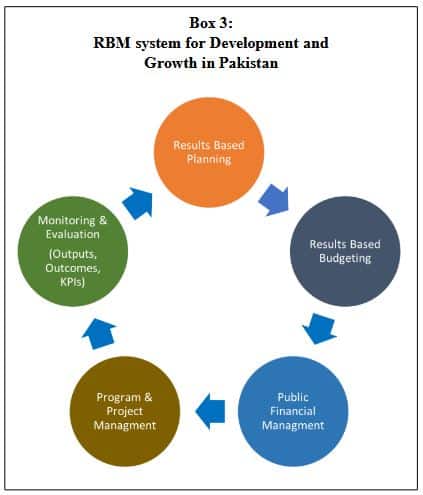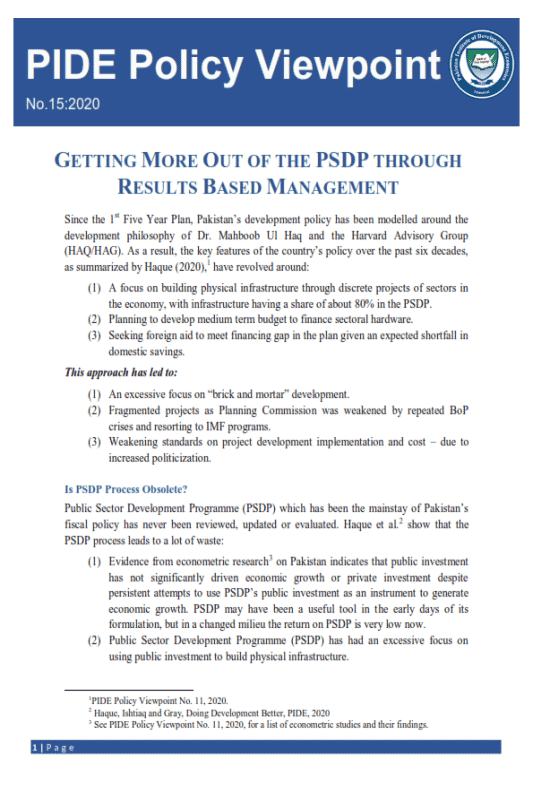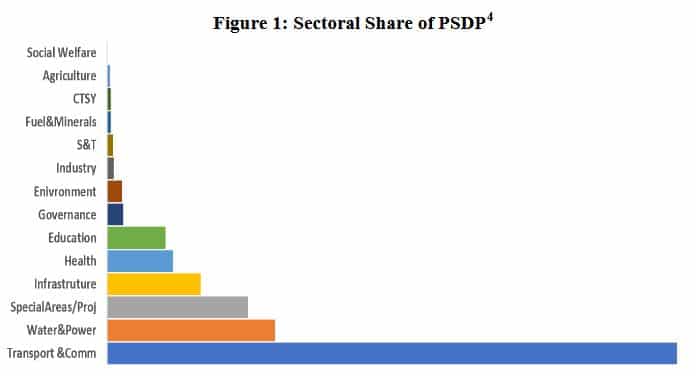
Pakistan Institute of Development Economics
- Home
Our Portals
MenuMenuMenuMenuMenuMenuMenu - ResearchMenuMenuMenuMenuMenuMenuMenu
- Discourse
- The PDR
- Our Researchers
- Academics
- Degree Verification
- Thesis Portal
- Our Portals
Getting More Out Of The PSDP Through Results Based Management
Getting More Out of the PSDP through Results Based Management
Since the 1st Five Year Plan, Pakistan’s development policy has been modelled around the development philosophy of Dr. Mahboob Ul Haq and the Harvard Advisory Group (HAQ/HAG). As a result, the key features of the country’s policy over the past six decades, as summarized by Haque (2020),[1] have revolved around:
- (1) A focus on building physical infrastructure through discrete projects of sectors in the economy, with infrastructure having a share of about 80% in the PSDP.
- (2) Planning to develop medium term budget to finance sectoral hardware.
- (3) Seeking foreign aid to meet financing gap in the plan given an expected shortfall in domestic savings.
This approach has led to:
- (1) An excessive focus on “brick and mortar” development.
- (2) Fragmented projects as Planning Commission was weakened by repeated BoP crises and resorting to IMF programmes.
- (3) Weakening standards on project development implementation and cost – due to increased politicization.
Is PSDP Process Obsolete?
Public Sector Development Programme (PSDP) which has been the mainstay of Pakistan’s fiscal policy has never been reviewed, updated or evaluated. Haque et al.[2] show that the PSDP process leads to a lot of waste:
- (1) Evidence from econometric research[3] on Pakistan indicates that public investment has not significantly driven economic growth or private investment despite persistent attempts to use PSDP’s public investment as an instrument to generate economic growth. PSDP may have been a useful tool in the early days of its formulation, but in a changed milieu the return on PSDP is very low now.
- (2) Public Sector Development Programme (PSDP) has had an excessive focus on using public investment to build physical infrastructure.
__________________________
[1]PIDE Policy Viewpoint No. 11, 2020.
[2] Haque, Mukhtar, Ishtiaq and Gray, Doing Development Better, PIDE, 2020.
[3] See PIDE Policy Viewpoint No. 11, 2020, for a list of econometric studies and their findings.
The emphasis is on “brick and mortar” in our projects. PSDP has developed roads, buildings for education, sport, and entertainment but without managing them for a return. The sectoral share of PSDP from 2018 shows that we are yet to deviate from the ‘brick & mortar’ policies. (See Figure 1)
(1) PSDP is heavily politicized. MNAs push and pull in their constituencies which leads to waste. Bureaucracy too builds offices, training academies that have huge excess capacity.
(2) Leaders waste money by using PSDP to spend on favourite projects which may not be the best or the most required.
(3) There was a good PSDP process based on a mandatory cost-benefit analysis and several in-depth reviews, but no one wants to subject themselves to that disciplines. Instead everyone uses executive authority to bypass the system.
(4) R&D and capacity building are not part of the PSDP despite being modern drivers of growth.
(5) Government departments have an incentive to propose projects without a clear business plan on how to later operate them to maximize returns.
(6) The emphasis on building has led to a neglect of human resource management leading to continual brain drain and declining government productivity.
(7) Projects are poorly managed leading to cost and time overruns. These have huge implications for realized returns of the projects.
The World Has Gone Beyond Brick & Mortar
Haq/HAG model was developed at a time of extreme infrastructure shortage and when globalization had not happened. It naturally focused on “brick and mortar” as well as
___________________
[4] Haque, Mukhtar, Ishtiaq and Gray, Doing Development Better, PIDE, 2020.
searching for aid. In addition, it merely looks at expenditures and not results. There was an evaluation process envisaged in the Planning Commission’s system (PC-IV and PC-V), but it has long ago fallen into disuse. For Pakistan to achieve rapid and sustained economic growth a rethink of our development policy and its implementation mechanisms is required.
Other countries both in the developing and the now-developed world have successfully broken the cycle of underdevelopment and achieved sustained rapid economic growth.[5] These countries despite being diverse in geography and culture, have invested in human development.
| Box 1: Beyond Brick and Mortar · Invest on capacity building of people · Open the economy to international trade and investment. · Deregulate to increase ease of doing business. · Use only nuanced government intervention to correct market failures: Do not distort markets unnecessarily. · Build inclusive institutions. · Invest in local universities and think-tanks. · Facilitate synergies between academia and markets to increase innovation. |
Infrastructure on its own is not enough unless it is accompanied by human capital that can utilize it efficiently. Furthermore, to go along with the capacity building of its population, these countries opened their economies to international trade and competition leading to growth of private enterprise. The private enterprise in turn led to an increase in innovation and knowledge creation which are integral ingredients of sustained rapid economic growth.[6]
There is another important piece of the jigsaw that needs to fall in place before a country can be on the road to economic growth. That is the role its institutions and in particular public institutions play in fostering inclusive environments that lead to competitive markets, innovation and ease of doing business.
Unfortunately, Pakistan historically has had extractive institutions due to its colonial legacy and these institutions instead of creating a vibrant regulatory, social and physical space for innovation have only worked to serve the purpose of the local elites.[7] Furthermore, these institutions have through excessive regulation and/or unnecessary subsidies distorted market and crowded out private investment that could have potentially led to innovation across multiple sectors.
Policies’ Implementation: Building a Performance Based System
Re-orienting sectoral focus is important, but an effective system will only evolve if mechanisms that track, monitor and evaluate it are put in place. Moving away from the philosophy of Haq/HAG model that focused on expenditure on inputs only, Pakistan needs to move towards a performance-based system. The Prime Minister himself has shared his desire to have such a system in place and its time we move towards implementing one.
_________________________
[5] Acemoglu and Robinson, Why Nations Fail, 2013, pg. 468.
[6] Framework for Economic Growth, PIDE, 2020, pg. 36.
[7] Haque, N. Looking Back: How Pakistan Became an Asian Tiger By 2050, 2017, pg. 92-111.
The Planning Commission’s Framework for Economic Growth (FEG)[8], approved by the National Economic Council (NEC), proposed a performance-based system using Results Based Management (RBM) principles back in 2011. Unfortunately, the recommendations of this framework remain to be adopted.
The system that is proposed in FEG constitutes of the following steps:
(1) Each year the Planning Commission should coordinate with the Finance Ministry/ Department and articulate the Medium-Term Budgetary Framework (MTBF) within the overall macroeconomic situation. This MTBF should lay the foundation for allocation of 3-year rolling indicative budget ceilings.[9]
(2) Planning Commission should in this system cooperate with the in-line ministries/ departments in developing performance contracts for approval by the Cabinet. Once the contracts are approved, the Planning Commission should be the monitoring body reporting to the Cabinet.
(3) The Planning Commission should work with a ‘Public Financial Management’ team from Finance Ministry/Department and develop accounting systems capable of recording and reporting actual expenditures based on outputs and outcomes.[10]
| Box 2: FEG Proposed RBM Framework will facilitate: · Periodic identification of emerging constraints to economic growth through research and dialogue with all sectors and stakeholders. · Objectives, outputs & outcomes clearly defined in an overall development & growth strategy. · Systematic measuring of productivity and public service delivery through M&E system. · Fiscal allocations for projects based on outputs & outcomes. · Development and review of quantifiable plans regularly. |
Decentralization: NFC Award & 18th Amendment
Ever since the 18th Amendment major subjects such as health and education among others have been devolved to the provinces. In due course, at provincial level provinces should develop their own Medium-Term Budgetary Frameworks (MTBFs) in addition to their own Result Based Management and Evaluation mechanisms. The role of the Planning Commission should be strategically critical in coordinating with provincial planning and development departments, and also the finance departments to ensure that necessary processes are in place to enhance “planning, budgeting and monitoring within departments of the provincial governments”.[11]
________________________
[8] See Framework for Economic Growth, PIDE, 2020. It should be noted that the original role of the 5-year plan too was that of a medium-term budget that was growth oriented. The annual budget was then aligned to the MTBF. Both MOF and IMF found that discipline to be incompatible with short term adjustment especially as such adjustment would require deep structural reform.
[9] Framework for Economic Growth, PIDE, 2020, pg. 133.
[10] Ibid., pg. 134.
[11] Ibid., pg. 134. For more details on how to implement the RBM see Haque et.al, 2020. Framework for Economic Growth.
The Future is Policy and Reform
Acemoglu and Robinson (2013) have summarized global evidence to point out that the path to sustainable growth acceleration lies in reform and policy. This important message also suggests that our growth policy must no longer rely on the Haq/HAG model.
To do this with a small amount of investment, the Planning Commission must seek deregulation and market building mechanisms. Instead of brick and mortar, challenge grants could be an important source for change. Some examples of these could be:
(1) Challenge Grant Funds for deregulation of the real estate sector in cities in line with Prime Minister’s vision based on number of tower cranes on the ground in city centers or number of apartments commissioned in city centers.
(2) Market development grants to cities, provinces and markets based on clear targets of number of transactions in a quarter. Examples of this could be:
- To enable cities to develop electronic platforms for real estate titling and transactions.
- To develop commodities markets with storage in various small agri-based towns.
- To allow the SECP to develop a market development plan that seeks to broaden and deepen the market. The making of this plan could be a PC-II and then the reform plan if funding is required can be a PSDP loan.
(3) Health sector productivity grants are needed but it should be kept in mind that health is a provincial and local subject after the 18th The Planning Commission can have matching grants for credible, implementable and monitor-able plans submitted by local health systems that need improvement. This will combine central injection of funds to the decentralized funding streams that are trying to tackle the issues at a local level.
(4) Education grants can be commissioned but new campuses’ development should be halted and existing universities and schools that have developed some online capability should be asked to present common programs for quality online teaching capability that Planning Commission in collaboration with HEC should support. Making these programs monitorable will be the key. Some indicators that can be used to track these programs could be capacity utilization, peer-reviewed course content creation, student satisfaction surveys and professional body reviews among others.
(5) Kick starting the knowledge economy is very important. For too long the buzz word “knowledge economy” has been used without much clarification. It should be noted that the term and what is represents are of little use unless existing research capabilities are increased. It is time that the Planning Commission developed methods to catalyze some research beyond the HEC. We need to prime our research system to grow and take on its responsibilities. It will take a while, therefore it is paramount that we begin at the earliest. Examples of mechanisms that could be developed for research activity to take off include:
(a) Peer Bodies to Evaluate Proposals for Theme-based Research
The Planning Commission should set up research themes and let a panel of both local and external eminent researchers adjudicate and provide rapid research for policy, markets and industry. The emphasis of this should be to provide research on local problems instead of publications meant for external market consumption.
(b) Planning Commission can Partner with Industry to Fund Critical Research to Their Sectors
With matching funds, the Planning Commission can initiate research on key issues related to sectoral interests. Processes can be identified to make research happen in the country to address burning questions on a fast track basis.
(c) Tax Policy and Administration Reform
Tax Policy and administration reforms should be the first themes that our academia vigorously takes up. This would be an important step towards having wide debate on important subjects that are impeding development. These central topics have long been in hand of external consultants and it is about time that our academia takes them up.
(6) SME and micro commerce growth are vital for the country. Planning Commission can use the PSDP to kickstart local commerce by working with Ministry of Commerce and local authorities to develop frameworks for the poorer segments of society. Some examples of such frameworks could be:
(a) Street Vending Frameworks for Cities that Lack Them
Putting street vending frameworks in place could provide employment to millions of people. We estimate that with proper framework there could be 50,000 of such enterprises in large cities with a possible employment of about 2 or 3 persons per such enterprise i.e. 100,000 – 150,000 employment opportunities. Cities can be incentivized with a PSDP grant to put in place regulatory frameworks for such enterprises. The number of vendors and frameworks can easily be monitored.
(b) Small Enterprises Coming Out of Crisis
In collaboration with local chambers and universities, frameworks can be developed for supporting SMEs as they come out of a crisis. For example:
(i) SME loans be made available through local chambers and SME associations but monitored and evaluated by local universities and schools generating both research and community development.
(ii) Regulatory burden of SMEs can be linked with local universities and even high schools to review the regulatory burden and seek changes. The Planning Commission can be a catalyst for change by facilitating these linkages.
Employment insurance and pension development market-based mechanisms can perhaps come into the picture at a later stage when markets have developed and transparency has increased. These could be in the shape of investment schemes in which employees of SMEs could invest with these investments acting as employment insurance. The whole process of the recommended Results Based Management is summarized in Box 3. Each step of this cycle involves different roles from different ministries. These are:
- Results Based Planning—An overall growth strategy implemented by ministries and departments—coordinated by the Planning Commission. Overall objectives, baseline statistics and KPIs identified.
- Results Based Budgeting—Each year Planning Commission with Finance Ministry allocates fiscal budgets for ministries/departments
- Public Financial Management—Planning Commission facilitates funding to specific ministries through liaison with Finance Ministry. Specific ministries formulate their own ‘Output/KPIs Based Budgets’. Planning Commission reports actual expenditure on predetermined outputs.
- Program & Project Management—Each ministry/department is responsible for implementation of its approved projects and quarterly reporting of outputs achieved and funds spent to Planning Commission.
- Monitoring & Evaluation—In addition to ensuring quarterly reporting by each ministry’s/department’s Principal Accounting Officer, Planning Commission devises M&E systems that measure yearly progress against predetermined outputs for each ministry/ department. Next year’s planning & budgetary adjustments are made based on this M&E analysis of outputs & KPIs.
 If done right the Planning Commission could utilize relatively small amount of funding to mobilize a large amount of rethinking that is necessary for an increase in productivity. Having said that, this approach will require considerable fresh research and thought for which we should try to mobilize our universities and our local intelligentsia. In doing so, this will also reduce our over-reliance on donors and foreign consultants that has created a policy mess since the early days of Pakistan.[12]
If done right the Planning Commission could utilize relatively small amount of funding to mobilize a large amount of rethinking that is necessary for an increase in productivity. Having said that, this approach will require considerable fresh research and thought for which we should try to mobilize our universities and our local intelligentsia. In doing so, this will also reduce our over-reliance on donors and foreign consultants that has created a policy mess since the early days of Pakistan.[12]
_______________________
[12]Markus Daechsel in his 2015 Book ‘Islamabad and the Politics of International Development in Pakistan’ expounds upon one such example of how international consultants bring ideas to Pakistan that are often removed from its milieu and hence instead of aiding in development create a conundrum. The story Daechsel tells is of the Greek architect, Constantinos A. Doxiadis, who designed Pakistan’s capital city Islamabad. Ironically, he was also the designer of Korangi Pilot Township (for refugees & slum-dwellers) near Karachi and had extensive input in drafting of Pakistan’s First Five-Year Development Plan.
REFERENCES
Acemoglu, Daron and Robinson, James A. (2013). Why Nations Fail. London: Profile Books.
Daechsel, M. (2015) Islamabad and the Politics of International Development in Pakistan. Cambridge: Cambridge University Press.
Haque, Nadeem Ul (2017). Looking Back: How Pakistan Became an Asian Tiger by 2050. 1st ed. Karachi: KITAB(Pvt.) Limited.
Haque, Nadeem Ul, Mukhtar, H., Ishtiaq, Nohman, and Gary, J. Gray (2020), Doing Development Better. Islamabad: Pakistan Institute of Development Economics.
Haque, Nadeem Ul and team (2020) Framework for Economic Growth. Islamabad: Pakistan Institute of Development Economics. https://file.pide.org.pk/pdf/Framework-for-Economic-Growth-Pakistan.pdf.




